 Last additions - Otsu 大津市 Last additions - Otsu 大津市 |

The first Zeze Castle lord was Toda Kazuaki who moved from Otsu Castle. The Zeze-han domain was thereby established. The castle was abolished in 1870. 戸田 一西.Jul 12, 2009
|
|

Jul 12, 2009
|
|

Zeze Castle monument 膳所城跡公園Jul 12, 2009
|
|

Jul 12, 2009
|
|

Zeze Castle monument. This park was part of the Honmaru. The castle was on a peninsula jutting into Lake Biwa. It was one of Japan's greatest lakeside castles. 膳所城跡公園Jul 12, 2009
|
|

Jul 12, 2009
|
|

Zeze Castle was controlled by a fudai daimyo, a lord with close ties to the Tokugawa. It was considered a strategic location being close to the Tokaido Road and Seta-no-Karahashi Bridge. Jul 12, 2009
|
|

Zeze Castle Park, Otsu.Jul 12, 2009
|
|
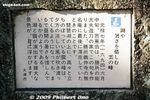
Jul 12, 2009
|
|

Jul 12, 2009
|
|
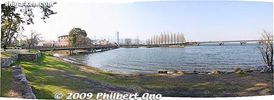
Lakeside at Zeze Castle Park.Jul 12, 2009
|
|

Walking path along Zeze Castle Park.Jul 12, 2009
|
|

Jul 12, 2009
|
|

Jul 12, 2009
|
|

Zeze Castle Park also has No. 4 High School cherry blossoms planted here in memory of the college rowers from Kanazawa University who died in a rowing accident on Lake Biwa in April 1941.Jul 12, 2009
|
|

Jul 12, 2009
|
|

Gate to Zeze Castle Park with cherry blossoms in full bloom in April. 膳所城跡公園 MAPJul 12, 2009
|
|

Gate to Zeze Castle Park 膳所城跡公園Jul 12, 2009
|
|

Zeze Castle wallJul 12, 2009
|
|

Zeze Castle gate and cherry blossoms.Jul 12, 2009
|
|

Priest Enchin (Chisho-daishi) also used the sacred well water for a succession ceremony and called the temple, "Miidera" using the kanji for "three wells." The official name of "Onjoji" was given by Emperor Temmu. Back of NioJul 12, 2009
|
|

About Kojo-in Kyakuden. It also has a Japanese garden not open to the public. 光浄院客殿Jul 12, 2009
|
|
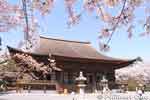
Miidera's Kondo Hall and cherry blossoms in Otsu.Jul 12, 2009
|
|

On the left in the back are steps going up to the lookout deck. A must-see vantage point.Jul 12, 2009
|
|

Jul 12, 2009
|
|

Gate to Kangaku-in Hall, school for priests at Miidera temple in Otsu. Closed to the public.Jul 12, 2009
|
|

Jul 12, 2009
|
|

Miidera's Three-story pagoda (Sanju-no-to)Jul 12, 2009
|
|

Kondo Hall Jul 12, 2009
|
|

Steps going to Issaikyo-zo Hall.Jul 12, 2009
|
|

Miidera templeJul 12, 2009
|
|

Jul 12, 2009
|
|

Kondo Hall carvingsJul 12, 2009
|
|

Cherry blossoms in April.Jul 12, 2009
|
|

Miidera's Three-story pagoda (Sanju-no-to)Jul 12, 2009
|
|

Issaikyo-zo Hall is a storehouse for all of the temple's Buddhist scriptures and valuable books. Built in the Muromachi Period and moved here from Yamaguchi Pref. in 1602 by Lord Mori Terumoto. Important Cultural Property. 一切経蔵Jul 12, 2009
|
|

This is the closest we can get to Kangaku-in Hall, a National Treasure at Miidera temple in Otsu.Jul 12, 2009
|
|

View of central Otsu which is experiencing a building boom along the lake shore. This has prompted local residents to seek a building height limit, otherwise the lake would disappear from view.Jul 12, 2009
|
|
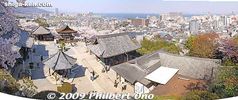
The lookout point gives the best views. The Kannon-do is on the left. Central Otsu can be seen in the distance as well as Lake Biwa.Jul 12, 2009
|
|

Nagara Jinja ShrineJul 12, 2009
|
|

About Kangaku-in Hall.Jul 12, 2009
|
|

Jul 12, 2009
|
|

Jul 12, 2009
|
|

On the right of the Kancho-do is the three-story pagoda (Sanju-no-to). It was moved from Fushimi Castle in Kyoto in 1601 by Tokugawa Ieyasu. Important Cultural Property. 三重塔Jul 12, 2009
|
|

Next to the Kondo hall is the famous Mii Bell Pavilion (Mii-no-Bansho). It is one of the Omi Hakkei (Eight Views of Omi) depicted in ukiyoe woodblock prints. Dating from the Momoyama period, it is an Important Cultural Property.Jul 12, 2009
|
|

Moon-viewing stage 勧月舞台 and cherry blossoms at Miidera with Lake Biwa in the background.Jul 12, 2009
|
|

Kondo Hall and cherry blossoms.Jul 12, 2009
|
|

On the lookout deck.Jul 12, 2009
|
|

Jul 12, 2009
|
|

Jul 12, 2009
|
|
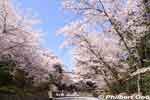
Miidera's cherry blossoms are also lit up at night. (See photos at bottom.)Jul 12, 2009
|
|

View from the bridge during cherry blossom season, looking toward the Kondo Hall.Jul 12, 2009
|
|

Kondo Hall carvingsJul 12, 2009
|
|

Somewhat away from the central area of Miidera is another National Treasure called Kojo-in Kyakuden. Unfortunately, it's closed to the public. All you see is this wall and a roof.Jul 12, 2009
|
|

Mii Bell Pavilion (Mii-no-Bansho) on the right. The small building on the left is a gift shop where you buy a ticket to ring the bell.Jul 12, 2009
|
|

Jul 12, 2009
|
|

Kannon-do on the left.Jul 12, 2009
|
|

Kondo Hall and cherry blossoms.Jul 12, 2009
|
|

Near the Niomon Gate is the Shaka-do Hall (also called Jiki-do 食堂) which worships the Shaka Nyorai statue. Dating from the early Muromachi Period, an Important Cultural Property. Photography is not allowed inside.Jul 12, 2009
|
|

Steps going up to the Kondo Hall.Jul 12, 2009
|
|

Main entrance to Miidera (Onjoji) temple. It is the headquarters temple of the Tendai Jimon Buddhist Sect (founded by Priest Enchin) and former rival of Enryakuji temple on Mt. Hiei, also in Shiga. MAPJul 12, 2009
|
|

Jul 12, 2009
|
|

Next to the Kannon-do is the Bishamon-do Hall.Jul 12, 2009
|
|

The Kannon-do Hall stores many Kannon statues.Jul 12, 2009
|
|

Ishiyama-dera's stone is wollastonite (硅灰石) which looks gray or white when dry and black when wet. Tahoto pagoda can also be seen.Jul 12, 2009
|
|

Jul 12, 2009
|
|

Jul 12, 2009
|
|

Jul 12, 2009
|
|

Inside the Tahoto is this altar for Dainichi Nyorai. 大日如来Jul 12, 2009
|
|

Jul 12, 2009
|
|

Jul 12, 2009
|
|

San-mon Gate Deva King (right side).Jul 12, 2009
|
|

Ema votive tablets on which you write your prayers and wishes.Jul 12, 2009
|
|

Jul 12, 2009
|
|

WaterwheelJul 12, 2009
|
|

Moss on roofJul 12, 2009
|
|

Map of Ishiyama-deraJul 12, 2009
|
|

View of Seta River in spring from Ishiyama-dera. Ahead is Lake Biwa.Jul 12, 2009
|
|

The Hondo also has this Room of Genji.Jul 12, 2009
|
|

Jul 12, 2009
|
|

Jul 12, 2009
|
|

Jul 12, 2009
|
|

Jul 12, 2009
|
|

Straight ahead is the huge slab of black stone which gave the temple its name. Ishiyama-dera means "Stone Mountain Temple." The pagoda above is the Tahoto, a National Treasure and positioned perfectly for our line of sight from below.Jul 12, 2009
|
|

Ishiyama-dera's Hondo Hall altar. 本堂Jul 12, 2009
|
|

Jul 12, 2009
|
|

Jul 12, 2009
|
|

Ishiyama-dera also has a grove of plum blossoms which bloom in Feb.Jul 12, 2009
|
|

Jul 12, 2009
|
|

Ishiyama-dera's Hondo Hall 本堂Jul 12, 2009
|
|

Plum treeJul 12, 2009
|
|

View of fall leaves below Hondo Hall 本堂Jul 12, 2009
|
|

Jul 12, 2009
|
|

Ishiyama-dera's Moon-viewing Pavilion and cherry blossoms. Not open to the public. 月見亭Jul 12, 2009
|
|

Jul 12, 2009
|
|

Jul 12, 2009
|
|

The Tahoto was built in 1194 upon the patronage of Minamoto Yoritomo. It is Japan's oldest Tahoto and one of the three most famous ones.Jul 12, 2009
|
|

Statue of Lady Murasaki Shikibu.Jul 12, 2009
|
|

Ishiyama-dera's Hondo Hall, a National Treasure. 本堂Jul 12, 2009
|
|

Jul 12, 2009
|
|

Sutra Repository 経蔵Jul 12, 2009
|
|

Jul 12, 2009
|
|

Jul 12, 2009
|
|

The Sando path also has cherry trees in April. Late April brings azaleas.Jul 12, 2009
|
|

Jul 12, 2009
|
|

Jul 12, 2009
|
|

If you're a woman and sit on the rock under the Sutra Repository, you"re supposed be able to give birth safely. So don't be surprised to see a woman sitting under the building.Jul 12, 2009
|
|

Finally we see Ishiyama-dera's beautiful Tahoto pagoda, a National Treasure in Otsu.Jul 12, 2009
|
|

Inside Ishiyama-dera's Hondo Hall 本堂Jul 12, 2009
|
|

Ishiyama-dera stone marker during sakura season in April.Jul 12, 2009
|
|

Ishiyama-dera's stone is a National Natural Monument.Jul 12, 2009
|
|

Jul 12, 2009
|
|

After passing through Todamon Gate, there is the Sando path leading to the temple complex. See fall leaves in Nov. 参道Jul 12, 2009
|
|

Jul 12, 2009
|
|

Jul 12, 2009
|
|

Inside Bishamon-do Hall is Bishamon.Jul 12, 2009
|
|

Memorials next to Tahoto dedicated to Minamoto Yoritomo and Kamegayatsu. 源頼朝 亀ケ谷禅尼Jul 12, 2009
|
|

Cherry blossoms and Tahoto pagoda at Ishiyama-dera.Jul 12, 2009
|
|

View as we head toward the Tahoto pagoda.Jul 12, 2009
|
|

A Tahoto pagoda has two stories, a square roof, and a round building. 多宝塔Jul 12, 2009
|
|

Plum blossomsJul 12, 2009
|
|

San-mon Gate Deva King (left side)Jul 12, 2009
|
|

In fall.Jul 12, 2009
|
|

Japanese gardenJul 12, 2009
|
|

In fallJul 12, 2009
|
|

Closeup of the stone, designated as a Natural Monument.Jul 12, 2009
|
|

Fall leaves on a rock formation.Jul 12, 2009
|
|

Ishiyama-dera's weeping cherries and azalea bushes to bloom in late April.Jul 12, 2009
|
|
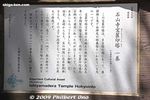
About the memorials.Jul 12, 2009
|
|
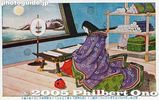
Lady Murasaki on a postcard.Jul 12, 2009
|
|

Jul 12, 2009
|
|

Jul 12, 2009
|
|

Early-blooming cherry blossoms.Jul 12, 2009
|
|

One-yen coins are stuffed into the cracks of the stone.Jul 12, 2009
|
|

At Ishiyama-dera, inside Room of Genji is a lifesize doll of Lady Murasaki Shikibu who wrote Tale of Genji, one of Japan's most famous novels.Jul 12, 2009
|
|

Hall to Moon-viewing Pavilion. Jul 12, 2009
|
|

About the TahotoJul 12, 2009
|
|

Bell tower 鐘楼Jul 12, 2009
|
|

Jul 12, 2009
|
|

Inside Ishiyama-dera's Hondo Hall 本堂Jul 12, 2009
|
|

Steps going to the Hondo Hall, Ishiyama-dera's main worship hall and a National Treasure.Jul 12, 2009
|
|

Jul 12, 2009
|
|

Ishiyama-dera is a temple complex of numerous buildings. This is the Kannon-do Hall.Jul 12, 2009
|
|

Ishiyama-dera's Japanese garden in spring.Jul 12, 2009
|
|

Tahoto pagoda, Ishiyama-deraJul 12, 2009
|
|

Jul 12, 2009
|
|

Sign explaining the Natural Monument.Jul 12, 2009
|
|

Mieido Hall dedicated to Kobo Daishi who founded Shingon Sect, to Roben 良弁僧正, the founder of Ishiyama-dera, and to Shunnyu Naiku 淳祐内供, the third head priest of Ishiyama-dera. 御影堂Jul 12, 2009
|
|

Plum blossoms.Jul 12, 2009
|
|

Jul 12, 2009
|
|

Jul 12, 2009
|
|

Jul 12, 2009
|
|

Jul 12, 2009
|
|

Ishiyama-dera in fallJul 12, 2009
|
|

Lady Murasaki supposedly wrote the novel in this room at Ishiyama-dera in Otsu.Jul 12, 2009
|
|

Jul 12, 2009
|
|

Impressive San-mon Gate, also called Todaimon. The defacto front gate of the temple. 東大門 MAPJul 12, 2009
|
|

Jul 12, 2009
|
|

Jul 12, 2009
|
|

In fallJul 12, 2009
|
|

In winter. The Omido Hall is on the left, and Bishamon-do on the right.Jul 12, 2009
|
|

Tahoto's ground floor has a dome-shaped ceiling and a square pent roof, a round second floor and square roof.Jul 12, 2009
|
|

Jul 12, 2009
|
|

Jul 12, 2009
|
|

Ishiyama-dera Hondo Hall, a National Treasure.Jul 12, 2009
|
|

This is what you see at the top of the stone steps. Founded in 749, Ishiyama-dera, belonging to the Shingon Buddhist Sect, is the 13th Temple of the Saigoku Pilgrimage.Jul 12, 2009
|
|

Bishamon-do Hall was built in 1773. 毘沙門堂Jul 12, 2009
|
|

Jul 12, 2009
|
|

Jul 12, 2009
|
|

Rennyo-do Hall, dedicated to Rennyo, prominent priest of the Jodo Shinshu Sect. 蓮如堂Jul 12, 2009
|
|

The bridges are for the highway and shinkansen trains.Jul 12, 2009
|
|
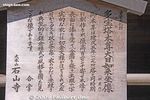
About the altar inside the Tahoto.Jul 12, 2009
|
|

Jul 12, 2009
|
|

Inside Rennyo-do Hall.Jul 12, 2009
|
|

Omido Hall 御影堂Jul 12, 2009
|
|

The stone in fall.Jul 12, 2009
|
|

Go up the stone steps and pass by a Shinto shrine. Jul 12, 2009
|
|

Cherry trees also greet you at the temple.Jul 12, 2009
|
|

Cherry blossoms along Seta River in Otsu, Lake Biwa's only outflowing river.Jul 12, 2009
|
|

Ishiyama-dera temple is a 10-min. walk from Ishiyama-dera Station on the Keihan Ishisaka Line. You can transfer to the Keihan Line at JR Ishiyama Station on the Tokaido Line.Jul 12, 2009
|
|

During early or mid-April, you can see cherry blossoms while walking from the station to the Ishiyama-dera along the Seta River.Jul 12, 2009
|
|

What to pray for at Hiyoshi Taisha.Jul 07, 2009
|
|

Jul 07, 2009
|
|

Jul 07, 2009
|
|

Unlike the other shrines, you can actually go inside this shrine hall.Jul 07, 2009
|
|

A small admission is charged to enter the shrine. 求法寺Jul 07, 2009
|
|

Jul 07, 2009
|
|

Next to Nishi Hongu is Usa-gu Shrine.Jul 07, 2009
|
|

Jul 07, 2009
|
|

Hiyoshi Taisha Shrine's boat dock is used during the Sanno Festival when they carry the portable mikoshi shrines on a boat.Jul 07, 2009
|
|

Jul 07, 2009
|
|

Jul 07, 2009
|
|

Secondary shrines in need of repair (donations welcome).Jul 07, 2009
|
|

Portable shrine storehouseJul 07, 2009
|
|

Sacred Rock for the monkey spirit. 猿の霊石Jul 07, 2009
|
|

Sacred Monkey cage on left and Sacred Horse on the right (dummy horse).Jul 07, 2009
|
|

Jul 07, 2009
|
|

Jul 07, 2009
|
|

Jul 07, 2009
|
|

Shirayama-gu Shrine Honden Hall. Important Cultural Property built in 1598. 白山宮 本殿Jul 07, 2009
|
|

Jul 07, 2009
|
|

Way to Shirayama-gu Shrine.Jul 07, 2009
|
|

Jul 07, 2009
|
|

Jul 07, 2009
|
|

It is actually a boat dock on Lake Biwa.Jul 07, 2009
|
|

Jul 07, 2009
|
|

Hiyoshi Taisha's Nishi Hongu Honden Hall, a National Treasure. It is only one of three buildings in Japan which represent the Hie-zukuri (日吉造り) architectural style. Higashi Hongu and Usagu and the two other shrines in this style.西本宮 �Jul 07, 2009
|
|

Usa-gu Shrine is also in the Hie-zukuri style, but smaller than Nishi Hongu. Important Cultural Property built in 1598.Jul 07, 2009
|
|

Jul 07, 2009
|
|

Path to Mt. Hachioji where there are two more shrines.Jul 07, 2009
|
|

Jul 07, 2009
|
|

Jul 07, 2009
|
|

Jul 07, 2009
|
|

Jul 07, 2009
|
|

Romon Gate to Higashi HonguJul 07, 2009
|
|

Jul 07, 2009
|
|

Nishi Hongu is also lit up at night during autumn.Jul 07, 2009
|
|

Jul 07, 2009
|
|

Jul 07, 2009
|
|

Jul 07, 2009
|
|

Hiyoshi Taisha's Sanno Torii rear view.Jul 07, 2009
|
|

Jul 07, 2009
|
|

Jul 07, 2009
|
|

Jul 07, 2009
|
|

Jul 07, 2009
|
|

Sacred Monkey. The monkey is the shrine god's messenger.Jul 07, 2009
|
|

Jul 07, 2009
|
|

Jul 07, 2009
|
|

Hiyoshi Taisha's Toshogu Shrine is a lesser shrine (massha 末社), a short walk from the main area of Hiyoshi Taisha.Jul 07, 2009
|
|

Jul 07, 2009
|
|

About Toshogu Shrine in Japanese.Jul 07, 2009
|
|

Jul 07, 2009
|
|

Monkey sculpture on all four corners of the Romon Gate at Nishi Hongu.Jul 07, 2009
|
|

Jul 07, 2009
|
|

Jul 07, 2009
|
|

Jul 07, 2009
|
|

Kamei Sacred WellJul 07, 2009
|
|

Jul 07, 2009
|
|

Thatched roof of Higashi Hongu.Jul 07, 2009
|
|

Hiyoshi Taisha's Higashi Hongu Shrine Honden, a National Treasure. This shrine worships the mountain god (Oyamakui-no-kami) of Mt. Hiei. Built in 1595. 東本宮 本殿 国宝Jul 07, 2009
|
|

Hiyoshi Taisha once had as many as 108 shrines, but Oda Nobunaga torched all of it along with Enryakuji temple on Mt. Hiei in the 16th century. The buildings were since rebuilt.Jul 07, 2009
|
|

Inside looks like brand new.Jul 07, 2009
|
|

Jul 07, 2009
|
|

Sanno Torii lit up in autumn at night in Nov. 山王鳥居Jul 07, 2009
|
|

Omiya Bridge at night in autumn when they light up the leaves.Jul 07, 2009
|
|

The shrine also has a torii gate on the lake shore, next to Sakamoto Castle.Jul 07, 2009
|
|
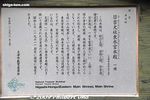
About the Higashi Hongu in Japanese.Jul 07, 2009
|
|

Kep walking straight and you will come to this Romon Gate at Nishi Hongu Shrine. 楼門Jul 07, 2009
|
|

Approaching Sanno ToriiJul 07, 2009
|
|

Usa-gu Shrine Honden 宇佐宮 本殿Jul 07, 2009
|
|

Jul 07, 2009
|
|

Jul 07, 2009
|
|
| 2449 files on 10 page(s) |
 |
 |
4 |  |
 |
|